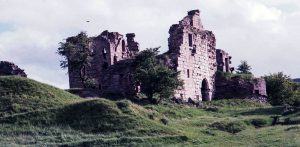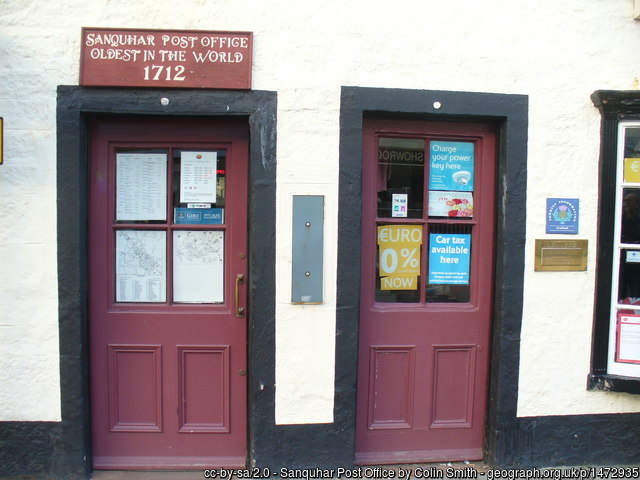
Sanquhar Home of World’s Oldest Post Office.
Looking for a base to explore the stunning scenery of the Nith Valley, or just travelling the A74 and in need of a break? Then the small but beautifully formed market town of Sanquhar may be just what you are looking for. Being conveniently placed about halfway between Dumfries & Ayr and a similar distance from Kilmarnock means that many will view it as a convenient stop for a comfort break, however as you will see, the town has a lot more to offer. So if we have piqued your interest then spend a few minutes with us and learn a bit about what this historic town has to offer. Starting with a brief history…
A Whirlwind History Of Sanquhar
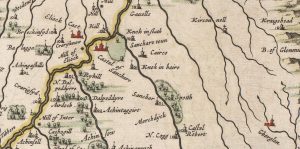
By Blaeu – image National Library of Scotland, Public Domain
The Early Days
Sanquhar whose name is thought to derive from the old Gaelic phrase for “old fort” (Seann Cathair) has been inhabited at one time or another since Neolithic times and in the 9th & 10th Centuries it is probable that Gaelic settlers lived in the area. However, it was firmly on the map in the Thirteenth-century where it played its part in the first Scottish War of Independence, being on the front line when the English invaded.
Genealogical records from the time show that at the time of the invasion, 1296 Thomas de Crichton swore fealty to Edward I for lands in Midlothian and soon after Sir William de Crichton became the 1st Laird of Sanquhar. The family built the now ruined castle as a family home in the 1400s and the Crichton family held sway over the area for a few hundred years presiding over Sanquhar becoming a Burgh of Barony in 1484, which allowed it to hold weekly markets.
Mary Queen of Scots sought refuge at Sanquhar Castle after her defeat at the Battle of Langside in 1568 and James IV granted the town the status of Royal Burgh in 1598. He also stayed at the castle in 1617 on his journey between London & Glasgow.
Troubles Ahead
By 1639, the Crichtons had moved to Ayrshire, selling their holdings in Sanquhar to the Earl of Queensbury who previously resided at Drumlanrig Castle about 9 miles away. Although not linked to the new laird, the subsequent part of the Seventeenth Century was a turbulent and violent one, as religious differences reared their head.
The devout Presbyterian’s known as the Covenanters led Scotland into various wars with England, and Sanquhar was their regional hotbed. Typified by Michael Cameron who in 1680 chose the town to read out and post here what would become the first “Sanquhar Declaration” effectively renouncing allegiance to the King (Charles II) an action that set a chain of events in place which eventually toppled the House of Stuart!
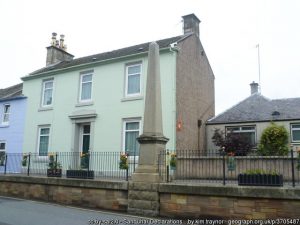
A monument to the Sanquhar Declaration stands in the Town to this day.
It would be fair to say that the 1600s were not the towns best era, however, things did improve.
Prosperity Arrives
Thanks in no small part to some significant investment put into roads by Sir Charles Douglas, 3rd Duke of Queensberry, agriculture began to flourish in the region by the early 18th century. By 1712 the town had a post office, coal mining began to expand and this led to a rise in weaving, carpet making and metal forging. In 1735 Famed Scottish Architect William Adam built the town’s Tolbooth (pinching much of the stone used from Sanquhar Castle).
The Sanquhar Wool Fair, held in July, became the mechanism for regulating the price of wool for Southern Scotland and it even developed its own textiles “Sanquhar knitting” a distinctive two-coloured pattern. Poet Robert Burns became a frequent guest at the Queensberry Arms in the High Street in the 1780s and by 1801 the population of Sanquhar had swelled to 2,350.
Carpet Kingdom
With all this wool around and weaving being a popular skill in the town it was not surprising that a large carpet factory was opened by the town in the 1830s and soon they were selling all around the world. The town’s population grew to 3,268 by 1831 during this period, and when the railway arrived in 1850 it seemed likely that this prosperity would continue.
By 1851, 4,071 called the town home and things were booming. Alas, the onset of the second industrial revolution and the rapid urbanisation of the major cities led to the main weaving factory closing in 1860 and with these well-paid jobs gone by 1881 the population was back down to 3,109.
Recent Challenges
In the early part of the 20th Century, the town had a bit of respite thanks to the Brick & Tile industry which benefitted from having coal nearby and of course the rail network to transport their wares, however, the loss of the railway station in the 1960s hit the town hard and the end of the UK coal mining industry in the 1980s did the rest. Today the population stands at about 2,100 nearly half its peak back in the halcyon days of the mid-1800s.
So there we have it. Who would have thought that a small town would cram so much into its history. Anyway how about a few interesting facts to lighten things up?
Not A Lot Of People Know That…
Poet Robert Burns used to be a frequent guest at the Queensberry Arms in the High Street. The town even gets a mention in his 1789 Poem “The Five Carlins”.
Sanquhar Post office is the oldest one still operating beating Stockholm in Sweden to the honour.
Speaking of the oldest Sanquhar also has the world’s oldest Curling society, formed in 1774!
In the 1922-23 season, local football club Nithsdale Wanderers FC reached the Scottish Cup 3rd Round, losing 2-0 to then League Two side FC Bo’ness.
The town was home to the famed Cycling club the Crawick Wheelers whose members set a number of Scottish Time Trial records in the 1930s & 40s
The Towns Railway station closed on the 6th December 1965 as part of the Beeching cuts (not the Christmas present they wanted), only to reopen in June 1994.
Anyway, now you have a bit of a feel for the towns history and some trivia just in case you decide to strike up a conversation, so now what? Well, how about some things to do when you pay the town a visit. Starting with…
Places to Visit in & Around Sanquhar
As we have mentioned Sanquhar is small but beautifully formed, so don’t expect a plethora of places to visit in the town, however, there are loads in the vicinity and it is well placed st serve as a base for those looking to explore this beautiful locale. Anyway, let’s get to it:
In the Town
The town’s main tourist attraction is the Tolbooth Museum which is a great way to get a feel for the history of the region. Located in a rather striking Georgian era townhouse, which also serves as the town clock offers an interesting insight into what life was like including details of the town’s jail and mining and weaving past. There is a nice display of traditional Sanquhar knitting including a range of the town’s famed black and white gloves, and surprisingly entrance is free (although a small donation would be appreciated). Sadly it does involve climbing up some steps so it is not wheelchair friendly.
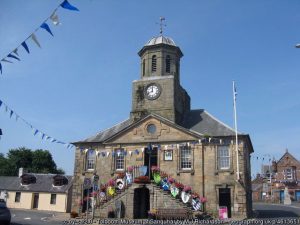
The Tolbooth Museum is an interesting place to visit but mind the steps.
The other main attraction is the post office which has a sign over the door of interest is the town’s post office confirming that it has been operating continuously since 1712. A nice selfie opportunity for the Instagram generation and of course you could send a card and get it postmarked in the town if you ask the postmaster nicely.
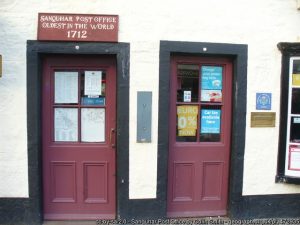
The High Street has a decent range of shops too and of course, there are a few nice places to eat. You can also look out for the informative plaques which adorn a few of the buildings.
Places Nearby
If you fancy a brisk walk or a short drive then the following are worth a visit:
The ruins of Sanquhar Castle are worth a visit but there is not much to do there other than feel a touch of sadness at the fact such a historic place is now so neglected, so if you want to see a proper working castle so to speak, then Drumlanrig Castle is only 10 miles away at nearby Thornhill. It has extensive grounds, and you can marvel at the opulent interior for a small fee during the summer season.
If you fancy a bit of a walk then the Crawick Multiverse, a land art project designed by world-famous landscape artist Charles Jenks is about 20 minutes walk away and is well worth a look, especially on a nice dry day.
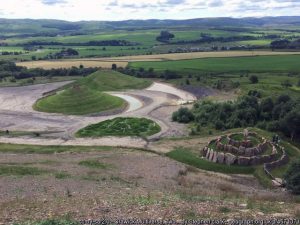
Finally, the two highest villages in Scotland – Wanlockhead and Leadhills are only a 20 minute or so drive away and, Wanlockhead is home to the Museum of Lead Mining.
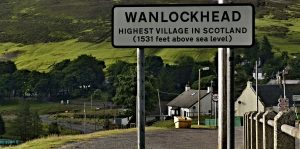
Things To Do
Experience the Sanquhar Riding of the Marches an annual event celebrating the town’s history. It features equine parades, decorated floats and plenty of street entertainment. It is also a time to indulge in a few drams, but it is generally very good-humoured. It normally takes place on the Saturday closest to 18 August.
Go Fishing
Sanquhar is on the River Nith – one of Scotland’s top Salmon rivers, and also has good runs of Sea Trout. Who knows you might catch your supper!
Take In A Football Match
Nithsdale Wanderers FC is the town’s club and they currently play in the South of Scotland League. Their home ground is Lorimer Park which can hold 1,000 fans and although the current club only dates from 2001 there is a long history of football in Sanquhar. The original Nithsdale Wanderers date from 1897 and their main claim to fame was winning the Scottish Third Division Championship in 1924-25 season. Sadly the original club was wound up in 1964 only to return some 37 years later. The team’s home colours are blue and white if you want to get a scarf.
Getting To Sanquhar
Sanquhar is surprisingly easy to get to from the West Coast of Scotland being on the A74 – the main route from Dumfries to both Ayr & Kilmarnock, and being around halfway from both it makes a nice stopping off point. It is also well linked to Carlisle which is on the M6 so even travelling from England is easy enough.
Train Services
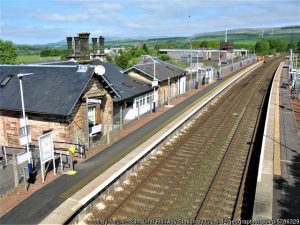
Sanquhar Station
The town’s railway station reopened in 1994 and offers connections to Dumfries & Glasgow. There are also irregular services to Newcastle.
Where to stay In Sanquhar?
If you want to stay on the high street then you could try the Nithsdale Hotel which is at the top of the street or the Glendyne Hotel. Both are very reasonably priced but have limited room space so booking in advance is recommended.
If a touch more luxury & seclusion is what you are looking for then the 3 Star Blackaddie Country House Hotel is the one to go for. We particularly liked the room names – all local game birds ranging from the Grouse with its four-poster bed to the compact Snipe. There are a few holiday cottages available too and we even found a flat on offer on Airbnb.
Thinking of Moving Here?
Sanquhar is a lovely place, however, this is not reflected in the house prices, which are very reasonable indeed by national standards. A quick look at Zoopla (July 2020) showed that the average sale price over the preceding 12 months was just over £89,000 and that prices were down over 5% over that timeframe.
Rental properties were conspicuous by their absence and the only one we could find at the time of writing (Early 2020) was a 3 bed flat, which was available for £500 cm.
So there we have it our quick guide to this interesting Scottish borders town which should be on your stop-off list even if it’s only on your route to Edinburgh or Carlisle.

